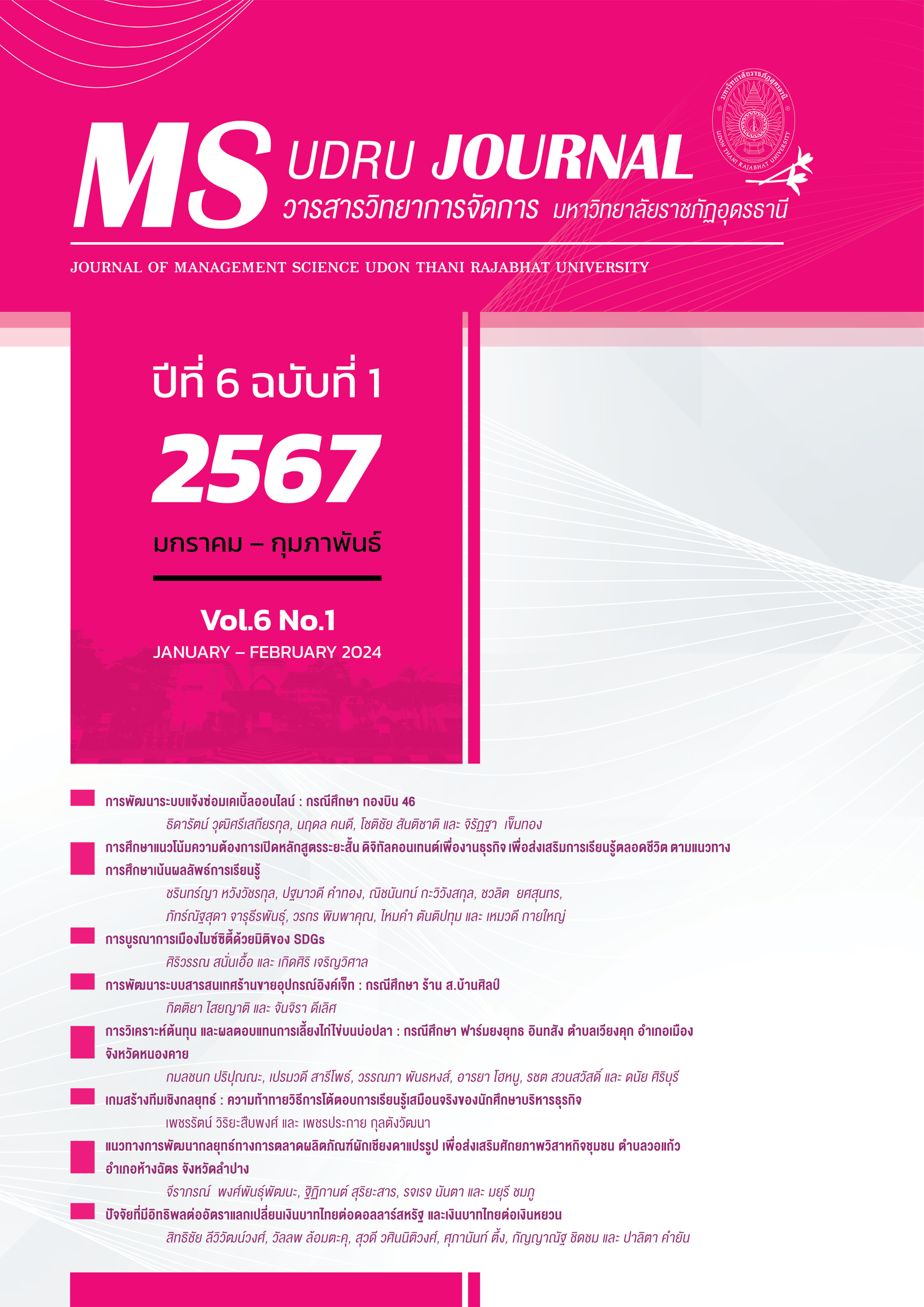การบูรณาการเมืองไมซ์ซิตี้ด้วยมิติของ SDGs
Main Article Content
บทคัดย่อ
อุตสาหกรรมไมซ์เป็นอุตสาหกรรมที่เชื่อมโยงอุตสาหกรรมการท่องเที่ยวและการบริการทำให้เกิดการพัฒนาพื้นที่ทางเศรษฐกิจของประเทศ ทั้งยังใช้เป็นเครื่องมือทางการตลาดที่เป็นประโยชน์ และเป็นกลยุทธ์ดึงดูดการลงทุนจากทั่วโลก บทความวิชาการนี้มีวัตถุประสงค์เพื่อศึกษาการบูรณาการเมืองไมซ์ซิตี้ด้วยมิติของเป้าหมายการพัฒนาที่ยั่งยืน (SDGs : Sustainable Development Goals) โดยมีการวิเคราะห์ รูปแบบองค์ประกอบที่สำคัญ 4 องค์ประกอบ คือ 1) การสร้างการรับรู้เมืองไมซ์ 2) การบริหารจัดการ โดยในการบริหารจัดการต้องกระตุ้นด้านเศรษฐกิจ ที่ทำให้เกิดการพัฒนาด้านสังคมและวัฒนธรรม และด้านสิ่งแวดล้อม 3) เกณฑ์การประเมินเมือง และ 4) เป้าหมายการพัฒนาที่ยั่งยืนด้วย SDGs โดยเกณฑ์การพัฒนาเมืองไมซ์จะต้องผ่านการวิเคราะห์และพิจารณาข้อที่มีความสัมพันธ์กับเป้าหมายการพัฒนาด้วย SDGs 17 ประการ เพื่อให้ได้เกณฑ์ที่มีการปรับและบูรณาการทำให้เกิดการสร้างเมืองไมซ์ซิตี้ที่มีความยั่งยืน
Article Details

This work is licensed under a Creative Commons Attribution-NonCommercial-NoDerivatives 4.0 International License.
บทความที่ได้รับการตีพิมพ์เป็นลิขสิทธิ์ของคณะวิทยาการจัดการ มหาวิทยาลัยราชภัฏอุดรธานี
ข้อความที่ปรากฏในบทความแต่ละเรื่องในวารสารวิชาการเล่มนี้
ไม่ใช่ความคิดเห็นและความรับผิดชอบของผู้จัดทำ บรรณาธิการ กองบรรณาธิการ และคณะวิทยาการจัดการ มหาวิทยาลัยราชภัฏอุดรธานี ความรับผิดชอบด้านเนื้อหาและการตรวจร่างบทความแต่ละเรื่องเป็นความคิดเห็นของผู้เขียนบทความแต่ละท่าน
References
ไกรศร วันละ. (2564). การขับเคลื่อนเป้าหมายการพัฒนาอย่างยั่งยืนของประเทศไทย. วารสาร มจร บาฬีศึกษาพุทธโฆสปริทรรศน์, 7(3), 56-66.
จีรนันท์ นาคสมทรง. (2563). เศรษฐกิจหมุนเวียนหนทางสู่การพัฒนาที่ยั่งยืนและบทบาทของการบัญชี. วารสารการบัญชีและการจัดการ มหาวิทยาลัยมหาสารคาม, 12(3), 157-172.
ดุษฎี ช่วยสุข และ ดลฤทัย โกวรรธนะกุล. (2558). การพัฒนาศักยภาพไมซ์ในจังหวัดขอนแก่นเพื่อรองรับการเป็นไมซซิตี้ของประเทศไทย. วารสารการบริการและการท่องเที่ยวไทย, 10(1), 15-29.
นฤมล เกษมสุข. (2560). ททท. ดัน “ท่องเที่ยว4.0” เคลื่อนเศรษฐกิจ. สืบค้นเมื่อ 1 มกราคม 2566 จาก, https://www.bangkokbiznews.com/business/756663.
บุญเลิศ จิตตั้งวัฒนา. (2554). ธุรกิจไมซ์ (MICE BUSINESS). นนทบุรี: เฟิร์นข้าหลวง. แผนพัฒนาเศรษฐกิจและสังคมแห่งชาติ. (2566). แผนพัฒนาเศรษฐกิจและสังคมแห่งชาติ ฉบับที่ 13 (2566-2570). สืบค้นเมื่อ 1 มกราคม 2566 จาก, http://nscr.nesdc.go.th/nesdp.
เยาวลักษณ์ ชาวบ้านโพธิ์. (2560). ความสามารถด้านการแข่งขันในอุตสาหกรรมไมซ์ของประเทศไทย. วารสารการวิจัยการบริหารการพัฒนา, 7(1), 56-65.
รังสรรค์ ลีเบี้ยว. (2564). การบูรณาการแนวคิดความรับผิดชอบต่อสังคมระดับโลก. วารสารวไลยอลงกรณ์ปริทัศน์, 11(1), 171-194.
วิลเลียม ดี.เอกเกอร์ส และ สตีเฟ่น โกลด์สมิท. (2552). การบริหารเครือข่ายภาครัฐ (Governing by networking) (จักร ติงศภัทิย์, แปล). กรุงเทพฯ: ซีเอ็ดบุ๊ค.
ศุภวรรณ ตีระรัตน์ และสันติธร ภูริภักดี. (2564). การรับรู้ในเสน่ห์เมืองรองของประเทศไทยที่ส่งผลต่อความพึงพอใจในธุรกิจการประชุมองค์กรและการท่องเที่ยวเพื่อเป็นรางวัล. วารสารมหาวิทยาลัยราชภัฏยะลา, 16(3), 337-347.
สุรัชสานุ์ ทองมี และประสพชัย พสุนนท์. (2563). การรับรู้ของหน่วยงานภาครัฐของจังหวัดนครราชสีมาที่มีต่ออุตสาหกรรมไมซ์และความสำคัญของปัจจัยตามเกณฑ์การประเมินเมืองไมซ์ (MICE City) ของสำนักงานส่งเสริมการจัดประชุมและนิทรรศการ (สสปน.). ศิลปศาสตร์ปริทัศน์, 15(2), 105-118.
เสรี วงษ์มณฑา และวิชยานันท์ พ่อค้า. (2560). แนวทางการเสริมสร้างศักยภาพของประเทศไทยให้เป็นเมืองเป้าหมายของไมซ์ (MICE). มนุษยศาสตร์ปริทรรศน์ คณะมนุษยศาสตร์ มหาวิทยาลัยศรีนครินทรวิโรฒ, 39(1), 96-112.
สำนักงานสภาพัฒนาเศรษฐกิจและสังคมแห่งชาติ. (2566). ยุทธศาสตร์ชาติ 20 ปี. สืบค้นเมื่อ 2 กุมภาพันธ์ 2566 จาก, http://nscr.nesdc.go.th/ns/.
สำนักงานส่งเสริมการจัดประชุมและนิทรรศการ. (2566). หลักเกณฑ์การประเมินเมืองเพื่อเป็นไมซ์ซิตี้. สืบค้นเมื่อ 1 มกราคม 2566 จาก, https://elibrary.tceb.or.th/th/Publication/Destination/6243.
สำนักงานส่งเสริมการจัดประชุมและนิทรรศการ. (2566). “MICE” อุตสาหกรรมไมซ์ นิยามบทใหม่แห่งการสร้างสรรค์งานอีเวนต์. สืบค้นเมื่อ 5 มกราคม 2566 จาก, https://www.businesseventsthailand.com/index.php/th/press-media/news-press-release/detail/1088-mice-is-the-new-definition-of-event-.
Aldebert, B., Dang, R.J. & Longhi, C. (2011). Innovation in the tourism industry: The Case of Tourism. Tourism Management, 32 (5), 1204-1213.
Mohammed Abdul-Kadhum Al-Ghiyadh & Saba J. Neamah Al-Khafaji. (2021). "Black and Red Urban Spaces; Crime and Terrorism," Turkish Journal of Computer and Mathematics Education, 12(12), 4437-4451.
Natalia Smagina. (2017). The internationalization of the Meetings-, Incentives-, Conventions- and Exhibitions- (MICE) industry: Its influences on the actors in the tourism business activity. Journal of Economics and Management, 27(1), 1732-1948.
Solomon, M. R. (1990). Consumer Behavior. New Jersey: Prentice-Hall.
Saenthong, N. (2018). Khumuprayuk chai rabop kanborihan ngan duai naeokhit Baep OKRs (Manual for applying the management system with the concept of OKRs). Bangkok: Se-ed Public Company Limited.
United Nations Industrial Development Organization (2002). Corporate social Responsibility Geneva Switzerland United nations. Retrieved June 12, 2023, from https://open.unido.org/api/documents/4692413/download/CORPORATE%20SOCIAL%20RESPONSIBILITY%20%20IMPLICATIONS%20FOR%20SMALL%20AND%20MEDIUM%20ENTERPRISES%20IN%20DEVELOPING%20COUNTRIES%20(22727.en.
United Nations. (2020). Sustainable Development Goals Geneva Switzerland. Retrieved March 1, 2023, from https://www.un.org/sustainabledevelopment/wpcontent/uploads/2019/01/SDG_Guidelines_AUG_2019_Final.pdf.
Xu, J.B. (2010). Perceptions of tourism products. Tourism Management, 31(5), 607-610.Zainab Hussein Ra'ouf, A. M. A.-. M. (2017). Facters affected trends of Contemporary Mosques Architecture, Retrieved March 20, 2023, from https://www.iasj.net/iasj/download/713dee4917b26337.

